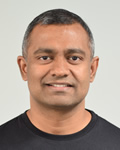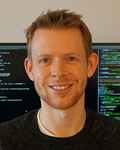
People to Watch 2018
Michael Jordan
Computer Science Professor
UC Berkeley (RISElab)
 Michael I. Jordan is the Pehong Chen Distinguished Professor in the Department of Electrical Engineering and Computer Science and the Department of Statistics at the University of California, Berkeley. He received his Masters in Mathematics from Arizona State University, and earned his PhD in Cognitive Science in 1985 from the University of California, San Diego. He was a professor at MIT from 1988 to 1998. His research interests bridge the computational, statistical, cognitive and biological sciences, and have focused in recent years on Bayesian nonparametric analysis, probabilistic graphical models, spectral methods, kernel machines and applications to problems in distributed computing systems, natural language processing, signal processing and statistical genetics. Prof. Jordan is a member of the National Academy of Sciences, a member of the National Academy of Engineering and a member of the American Academy of Arts and Sciences. He is a Fellow of the American Association for the Advancement of Science. He has been named a Neyman Lecturer and a Medallion Lecturer by the Institute of Mathematical Statistics. He received the IJCAI Research Excellence Award in 2016, the David E. Rumelhart Prize in 2015 and the ACM/AAAI Allen Newell Award in 2009. He is a Fellow of the AAAI, ACM, ASA, CSS, IEEE, IMS, ISBA and SIAM.
Michael I. Jordan is the Pehong Chen Distinguished Professor in the Department of Electrical Engineering and Computer Science and the Department of Statistics at the University of California, Berkeley. He received his Masters in Mathematics from Arizona State University, and earned his PhD in Cognitive Science in 1985 from the University of California, San Diego. He was a professor at MIT from 1988 to 1998. His research interests bridge the computational, statistical, cognitive and biological sciences, and have focused in recent years on Bayesian nonparametric analysis, probabilistic graphical models, spectral methods, kernel machines and applications to problems in distributed computing systems, natural language processing, signal processing and statistical genetics. Prof. Jordan is a member of the National Academy of Sciences, a member of the National Academy of Engineering and a member of the American Academy of Arts and Sciences. He is a Fellow of the American Association for the Advancement of Science. He has been named a Neyman Lecturer and a Medallion Lecturer by the Institute of Mathematical Statistics. He received the IJCAI Research Excellence Award in 2016, the David E. Rumelhart Prize in 2015 and the ACM/AAAI Allen Newell Award in 2009. He is a Fellow of the AAAI, ACM, ASA, CSS, IEEE, IMS, ISBA and SIAM.
Datanami: Congratulations on being named a Datanami Person to Watch in 2018! We’ve been closely following RISELab’s efforts, but what can we expect to see out of RISELab this year?
Michael Jordan: I’d like to highlight the RISELab project known as “Ray.” It’s quite far along, and indeed at this point it is ready for deployment in real-world settings. Ray is a distributed data analysis and decision-making system that focuses on handling very large numbers of heterogeneous workloads, as arise, for example, in reinforcement learning problems and model-search problems. Most existing large-scale data analysis platforms are block synchronous, which creates bottlenecks. Ray is not. Instead it aims to handle large numbers of tasks at very fine, diverse time scales.
Datanami: What do you see as some of the big challenges emerging in machine learning?
There are many areas that urgently need attention if machine learning is going to move in the direction of becoming a serious engineering discipline. We need to worry less about one agent making a single decision and more about a system making multiple correlated decisions. This arises, for example in areas such as transportation, finance, commerce or medicine, where a given algorithm may be making hundreds of thousands or even millions of decisions per day. There are constraints among these decisions; e.g., if the system sends every car to the same region of town that will produce traffic congestion. If a financial system recommends to everybody to buy the same stock that will destabilize the financial markets. Anytime a system makes recommendations in an economic system in which resources are limited one faces such load-balancing problems. Moreover, one faces statistical problems involving the growth in error rates when multiple decisions are being made, be they independent or correlated. Overall, our machine learning systems must become real systems, not just algorithms that make separate predictions for each data point. Also, machine learning systems need to provide more than predictions — they need to provide confidence intervals. Otherwise it is impossible to make reliable decisions. Such confidence intervals not only help determine which decision is best, but also when more data is needed before a decision can be made. Broadly speaking, we need to be able to do reliable statistical inference with time budgets. Another area that’s very important is causal inference, where we try to not only be able to predict but also to assert why something has happened. Only by inferring causes can we approach public policy decisions, where it’s important not only to know the goal, but to know the mechanisms that can achieve that goal. Another challenge is managing cloud-edge interactions, where we must make timely decisions based on distributed sources of knowledge. Another is sharing data across administrative and competitive boundaries. And finally, a longstanding challenge is that of bringing natural language semantics into contact with machine-learning systems.
Datanami: Regarding the state of data science education, do you think universities doing enough to satisfy demand from students and industry? How might we better approach the problem?
I think we need a wholesale revision of the curriculum in computer science and statistics. For example, if one considers an entry-level computer programming class, the examples and the projects are very often games or mathematical exercises that reside in a virtual world. Why not introduce inferential problems, and real-world data, in such classes? For example, one can learn to perform an A/B test using permutation methods from statistics, which can be programmed with a modicum of (say) Python. In particular one needs to know how to randomly shuffle lists, and plot histograms. Students are then empowered to conduct actual A/B tests, on problems that they are interested in. For example, is the composition of juries in a given county the same as the composition of the underlying population? This is an inferential problem involving statistical significance. Considerations such as these led us to design a new freshman-level course on Data Science at Berkeley, known as “DS 8,” which introduces computational thinking, inferential thinking and real-world problem solving in a unified way. Students learn to program (in Python), and they learn inferential principles and their realization as algorithms. They work with real-world data sets. Even without any mathematical background beyond arithmetic, students end up being able to understand, and implement, a range of ideas in parametric and nonparametric statistics. They learn to think about the social and ethical context of computing and inference. The course has been a major success, with over 2,000 students taking it each year. We also have classes that take this integrated perspective at the sophomore, junior and senior levels. A student coming out of this sequence is truly ready to call themselves a “Data Scientist.” As far as I’m concerned such a course sequence is a kind of liberal arts of the 21st century.
Datanami: What do you hope to see from the big data community in the coming year?
I hope to see more awareness of uncertainty and decision making under uncertainty. People are starting to become aware of biases and sampling issues and the effect that that could have, but there’s a much bigger set of issues dealing with where data comes from, where models come from and how uncertain one is about the choices that have been made in choosing models and gathering data. It’s important that systems are able to help protect people from over-optimism when they’re using data to make predictions and decisions.
Datanami: Outside of the professional sphere, what can you share about yourself that your colleagues might be surprised to learn – any unique hobbies or stories?
I’m a drummer. I’m currently playing in three different bands. I’ve performed in venues around the world, and have played a range of musical styles ranging from late 1980’s pop to punk rock to Latin. It’s a very complementary activity to my intellectual life.









































